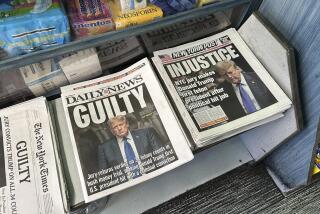PERSPECTIVE ON MEDIA : ‘Information Pollution’ Is Real : Talk about ‘polluting the jury pool’ is just a metaphor, but it gives life to the new media ecology movement.
- Share via
Rising to the surface of debate surrounding the O.J. Simpson trial is the notion of information as pollution. Judge Lance A. Ito and lawyers for both the prosecution and the defense all have talked about media exposure possibly “polluting” the jury pool. Technically speaking, this is a metaphor, but it’s one that is extremely useful to understanding the growing media-literacy movement.
Behind the metaphor lies an awareness that not everything that pours out of that tube or out of those speakers is good for you. More information may not necessarily be better information. The idea is starting to take hold, that is, that some kinds of information--particularly but not solely with respect to a jury’s deliberations during a trial--may be noxious, harmful or even, in some respects, poisonous.
The idea is not a new one, but it is newly salient and persuasive this time around. Many of us remember the wartime slogan, “Loose lips sink ships.” That was a dramatic way of reminding Americans during the two world wars that the free flow of certain information could cause mortal damage. More recently, during the Persian Gulf War, when Saddam Hussein caused propagandistic interviews with downed American airmen to be aired on CNN, the notion of information and imagery as potentially toxic to the morale of U.S. forces took hold.
More recently still, in the debate over violence on television, one increasingly hears scholars such as George Gerbner, dean emeritus of the Annenberg School for Communication at the University of Pennsylvania, speaking explicitly about launching a “media ecology movement” and arguing for the need to think in terms of conserving the quality of our media environment. Gerbner calls persuasively for a cleanup of what he calls “happy violence” on television, as if images of violence presented without their negative consequences were a toxic effluent being poured into the air that surrounds us.
We are increasingly aware, in other words, that what we unthinkingly refer to as “the media” literally is the stuff, the matter, the environment in which we live. While our bodies live on nutritious food, clean water and fresh air, our minds are nourished (or not) by both the quantity and the quality of the information and images that we expose them to. Information and imagery provide, that is, our brain’s sole food and the only air it has to breathe.
Truth and falsity are essential to the quality of our information environment, but they are not the only relevant variables. In the courtroom, the question of whether information, accurate or not, may be prejudicial to jurors’ judgment helps to determine (in Judge Ito’s terms) the degree of possible “pollution of the pool.”
The power of images as role models for behavior establishes a further set of criteria for evaluating media ecology by raising such questions as, does this picture advocate or endorse helpful or harmful behavior? In a currently controversial example, the Postal Service has issued a stamp commemorating blues legend Robert Johnson; the stamp replicates an old photo of Johnson in which the cigarette between his lips has been air-brushed out. The “information” in the original photo may be more “truthful,” but the alteration furnishes further evidence that the idea of media ecology--”down with toxic imagery!”--is starting to stick.
The current courthouse discussions of preserving the jury pool from pollution by exposure to the wrong information have gone even further in planting the idea. We might even be led to hope that without spending a penny of real money, a “superfund” of sorts might be established to clean up the toxic waste dumps of our media by encouraging us to begin on our own to sort out what’s worth noting in the media from what’s worth nothing or worse. Media literacy means knowing how to avoid media litter.
Even amid the dross of the overplayed story of sex and violence surrounding the Simpson trial, a kernel of goodness can be found: Media environmentalism is born!
More to Read
The biggest entertainment stories
Get our big stories about Hollywood, film, television, music, arts, culture and more right in your inbox as soon as they publish.
You may occasionally receive promotional content from the Los Angeles Times.










